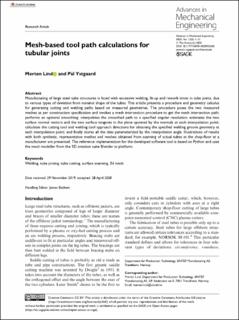| dc.contributor.author | Lind, Morten | |
| dc.contributor.author | Ystgaard, Pål | |
| dc.date.accessioned | 2022-05-06T08:44:17Z | |
| dc.date.available | 2022-05-06T08:44:17Z | |
| dc.date.created | 2020-08-11T15:44:47Z | |
| dc.date.issued | 2020 | |
| dc.identifier.citation | Advances in Mechanical Engineering, 12, (6). | en_US |
| dc.identifier.issn | 1687-8132 | |
| dc.identifier.uri | https://hdl.handle.net/11250/2994502 | |
| dc.description.abstract | Manufacturing of large steel tube structures is faced with excessive welding, fit-up and rework times in tube joints, due to various types of deviation from nominal shape of the tubes. This article presents a procedure and geometry calculus for generating cutting and welding paths based on measured geometries. The procedure poses the two measured meshes as per construction specification and invokes a mesh intersection procedure to get the mesh intersection path; performs an optional smoothing; interpolates the smoothed path to a specified angular resolution; estimates the two surface normal vectors and the two surface tangents in the plane spanned by the normals at each interpolation point; calculates the cutting tool and welding tool approach directions for obtaining the specified welding groove geometry at each interpolation point; and finally stores all the data parameterized by the interpolation angle. Illustrations of results with both synthetic, representative meshes and meshes obtained from scanning of actual tubes at the shop-floor at a manufacturer are presented. The reference implementation for the developed software tool is based on Python and uses the mesh modeller from the 3D creation suite Blender as platform. | en_US |
| dc.language.iso | eng | en_US |
| dc.publisher | SAGE | en_US |
| dc.rights | Navngivelse 4.0 Internasjonal | * |
| dc.rights.uri | http://creativecommons.org/licenses/by/4.0/deed.no | * |
| dc.subject | Welding | en_US |
| dc.subject | Tube joining | en_US |
| dc.subject | Tube cutting | en_US |
| dc.subject | Surface scanning | en_US |
| dc.subject | 3D mesh | en_US |
| dc.title | Mesh-based tool path calculations for tubular joints | en_US |
| dc.type | Peer reviewed | en_US |
| dc.type | Journal article | en_US |
| dc.description.version | publishedVersion | en_US |
| dc.rights.holder | © The Author(s) 2020. This article is distributed under the terms of the Creative Commons Attribution 4.0 License (https://creativecommons.org/licenses/by/4.0/) which permits any use, reproduction and distribution of the work without further permission provided the original work is attributed as specified on the SAGE and Open Access pages (https://us.sagepub.com/en-us/nam/open-access-at-sage). | en_US |
| dc.source.pagenumber | 13 | en_US |
| dc.source.volume | 12 | en_US |
| dc.source.journal | Advances in Mechanical Engineering | en_US |
| dc.source.issue | 6 | en_US |
| dc.identifier.doi | 10.1177/1687814020933383 | |
| dc.identifier.cristin | 1822827 | |
| dc.relation.project | Norges forskningsråd: 282106 | en_US |
| cristin.ispublished | true | |
| cristin.fulltext | original | |
| cristin.fulltext | original | |
| cristin.qualitycode | 1 | |

